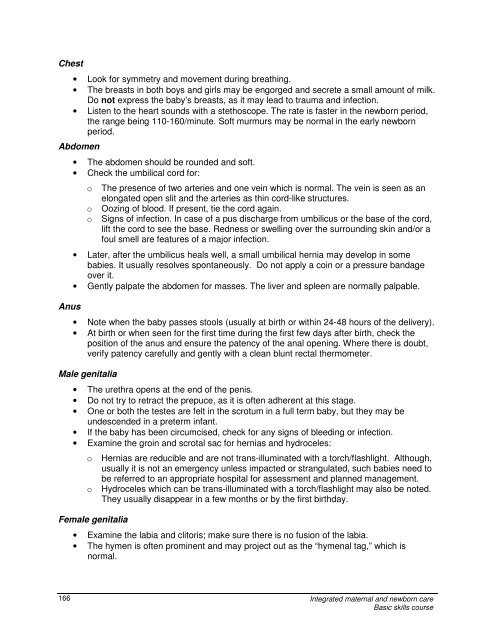Integrated Maternal and Newborn Care Basic Skills Course ...
Integrated Maternal and Newborn Care Basic Skills Course ...
Integrated Maternal and Newborn Care Basic Skills Course ...
You also want an ePaper? Increase the reach of your titles
YUMPU automatically turns print PDFs into web optimized ePapers that Google loves.
Chest<br />
• Look for symmetry <strong>and</strong> movement during breathing.<br />
• The breasts in both boys <strong>and</strong> girls may be engorged <strong>and</strong> secrete a small amount of milk.<br />
Do not express the baby’s breasts, as it may lead to trauma <strong>and</strong> infection.<br />
• Listen to the heart sounds with a stethoscope. The rate is faster in the newborn period,<br />
the range being 110-160/minute. Soft murmurs may be normal in the early newborn<br />
period.<br />
Abdomen<br />
Anus<br />
• The abdomen should be rounded <strong>and</strong> soft.<br />
• Check the umbilical cord for:<br />
o The presence of two arteries <strong>and</strong> one vein which is normal. The vein is seen as an<br />
elongated open slit <strong>and</strong> the arteries as thin cord-like structures.<br />
o Oozing of blood. If present, tie the cord again.<br />
o Signs of infection. In case of a pus discharge from umbilicus or the base of the cord,<br />
lift the cord to see the base. Redness or swelling over the surrounding skin <strong>and</strong>/or a<br />
foul smell are features of a major infection.<br />
• Later, after the umbilicus heals well, a small umbilical hernia may develop in some<br />
babies. It usually resolves spontaneously. Do not apply a coin or a pressure b<strong>and</strong>age<br />
over it.<br />
• Gently palpate the abdomen for masses. The liver <strong>and</strong> spleen are normally palpable.<br />
• Note when the baby passes stools (usually at birth or within 24-48 hours of the delivery).<br />
• At birth or when seen for the first time during the first few days after birth, check the<br />
position of the anus <strong>and</strong> ensure the patency of the anal opening. Where there is doubt,<br />
verify patency carefully <strong>and</strong> gently with a clean blunt rectal thermometer.<br />
Male genitalia<br />
• The urethra opens at the end of the penis.<br />
• Do not try to retract the prepuce, as it is often adherent at this stage.<br />
• One or both the testes are felt in the scrotum in a full term baby, but they may be<br />
undescended in a preterm infant.<br />
• If the baby has been circumcised, check for any signs of bleeding or infection.<br />
• Examine the groin <strong>and</strong> scrotal sac for hernias <strong>and</strong> hydroceles:<br />
o Hernias are reducible <strong>and</strong> are not trans-illuminated with a torch/flashlight. Although,<br />
usually it is not an emergency unless impacted or strangulated, such babies need to<br />
be referred to an appropriate hospital for assessment <strong>and</strong> planned management.<br />
o Hydroceles which can be trans-illuminated with a torch/flashlight may also be noted.<br />
They usually disappear in a few months or by the first birthday.<br />
Female genitalia<br />
• Examine the labia <strong>and</strong> clitoris; make sure there is no fusion of the labia.<br />
• The hymen is often prominent <strong>and</strong> may project out as the “hymenal tag,” which is<br />
normal.<br />
166<br />
<strong>Integrated</strong> maternal <strong>and</strong> newborn care<br />
<strong>Basic</strong> skills course

















